Earthjustice stands with western Alaska tribes and families after severe storms devastated entire communities, displacing more than 1,000 residents just before winter. Learn more and how you can help.
What the Tongass Needs is Time to Heal, Not More Logging
The Organized Village of Kasaan is fighting alongside other Southeast Alaska tribes and forest advocates to defend the Tongass National Forest.
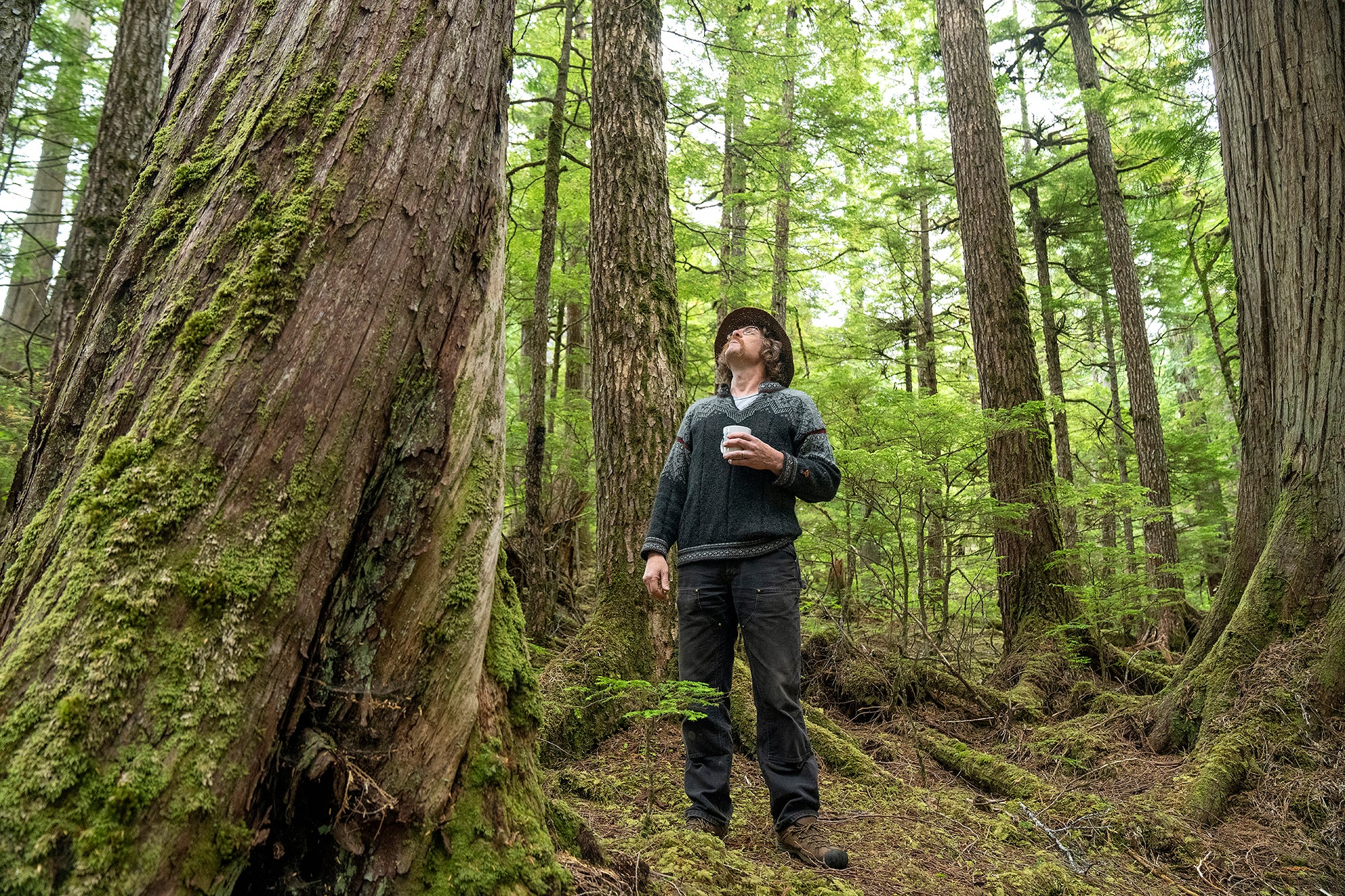
From the window of a seaplane flying over Prince of Wales Island in Southeast Alaska, dense stands of Sitka spruce, western hemlock, and red and yellow cedar stretch as far as the eye can see. The forest looks lush and beautiful. But it conceals deep scars from logging — and the major threat of more from the Trump administration.
Haida tribal members from the Organized Village of Kasaan say the ancient old-growth forests that once blanketed this island within the Tongass National Forest are now relatively rare. After decades of clearcutting, young-growth forests have grown in their place, but they aren’t the same. Road building and logging have destroyed essential habitat, degraded water quality, damaged salmon streams, caused landslides, contributed to climate change, affected food security and ways of life for the region’s tribes, and more.
In essence, intensive logging from the 1950s to the 1990s dealt a massive blow to the ecosystem that will take many hundreds of years to repair. And now, the Trump administration wants to restart industrial-scale logging, including cutting down what little remains of the old-growth trees within the Tongass.
Earthjustice represents tribal leaders in Kasaan, alongside other Southeast Alaska tribal leaders, small tourism business owners, commercial fishing operators, and conservationists who are fighting efforts to ramp up logging.
“Our clients in the Tongass include tribes that are in the heart of the timber region of Southeast Alaska,” explains Earthjustice Attorney Kate Glover, who has worked to protect the Tongass for more than a decade. “They’ve said, ‘We’ve seen enough, and it’s time to let the forest heal.’ Their cultures have intertwined with intact forests for millennia. But they’ve borne the brunt of the industrial clear cuts.”
Logging, including clearcutting, still occurs on the Tongass, but has significantly scaled back since the 1990s. One reason is the 2001 Roadless Rule, which helped shift forest management from a focus primarily on logging to conservation for the benefit of wildlife and people. The policy generally prohibits road construction and logging on 58.5 million acres of inventoried roadless areas on forest lands nationwide.
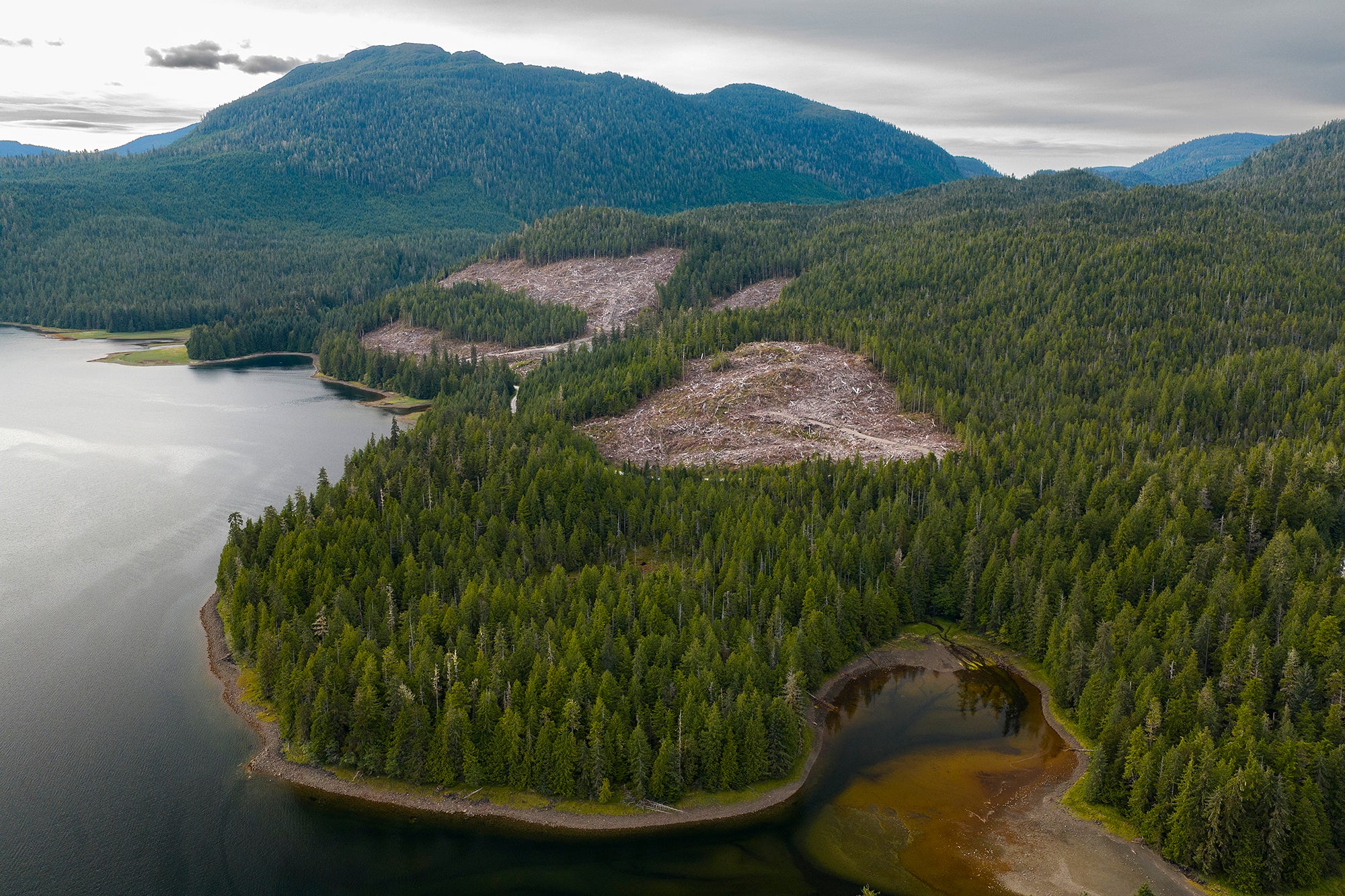
View of a clearcut on land owned by a State of Alaska corporation, adjacent to the Tongass National Forest on Prince of Wales Island, Alaska. (David Herasimtschuk for Earthjustice)
The rule didn’t stop all logging here or elsewhere — clearcutting has continued within and adjacent to the Tongass, some on Forest Service lands but also on lands owned by the State of Alaska, or a state-owned corporation or other landowners. But it provides important protections for the forest’s “inventoried roadless areas” covering approximately 9.5 million acres within the 17-million-acre Tongass National Forest.
President Trump signaled his intent to roll back the Roadless Rule on the first day of his administration in January. Then in March came a series of executive actions that called for ramping up timber production across all national forests. In June, the U.S. Department of Agriculture announced plans to strip Roadless Rule protections from forests nationwide, including Alaska’s Tongass National Forest.
President Mike Jones of the Organized Village of Kasaan said his tribe feels a responsibility to protect the Tongass, now and for future generations.
“The Tongass is the northern lung of this planet,” he said, because of its ability to store carbon — estimated at 20% of the carbon held within the entire national forest system. “We and many others, Indigenous or not, depend on healthy salmon runs. And you can’t have healthy salmon without healthy forests. What happens here has a global impact.”

Pink salmon spawning in Maybeso Creek, near Hollis, Alaska, Tongass National Forest. (David Herasimtschuk for Earthjustice)
A natural rhythm remains
Getting to Kasaan, population about 75, is not easy. From the Alaska mainland, people usually take a seaplane or ferry and then drive one to two hours down a paved and gravel road to Kasaan on the east side of the island. Once in Kasaan, time is measured more by the passing of the sun in the sky than what it says on your watch or phone.
Even though the forest has been hammered by decades of industrial logging, with some places like Prince of Wales especially harmed, the remoteness of the Tongass has helped protect it.
Because of its sheer size, the Tongass “remains the most intact of all of the forests in the national forest system,” said Tom Waldo, an Earthjustice attorney based in Juneau who helped lead the early days of Earthjustice’s legal fight to protect the Tongass. “We don’t have any extinct, or even any endangered species” within the forest. “It’s still an intact functioning ecosystem in a way that’s been lost in most of the lower 48 states.”
Stormy Hamar, a Haida artist and carver and a member of the Organized Village of Kasaan Tribal Council, understands Southeast Alaska’s logging history better than most people because he lived it. While living on a float house between Kasaan Bay and Coffman Cove, his parents ran a small, independent, mom-and-pop logging operation from a floating A-frame that pulled logs to the beach with a cable winch known as a “donkey.”
No one he knew who lived on Prince of Wales or elsewhere in Southeast Alaska profited much from logging, Stormy said, but he said it was a nice lifestyle for his family for a while. The damage from clearcutting happened over time, and after he had lived away in a mainland logging camp for many years and returned in 2005 to Kasaan, he said he was shocked by the devastation from clearcutting. “What happened to this place?” he recalls thinking at the time.
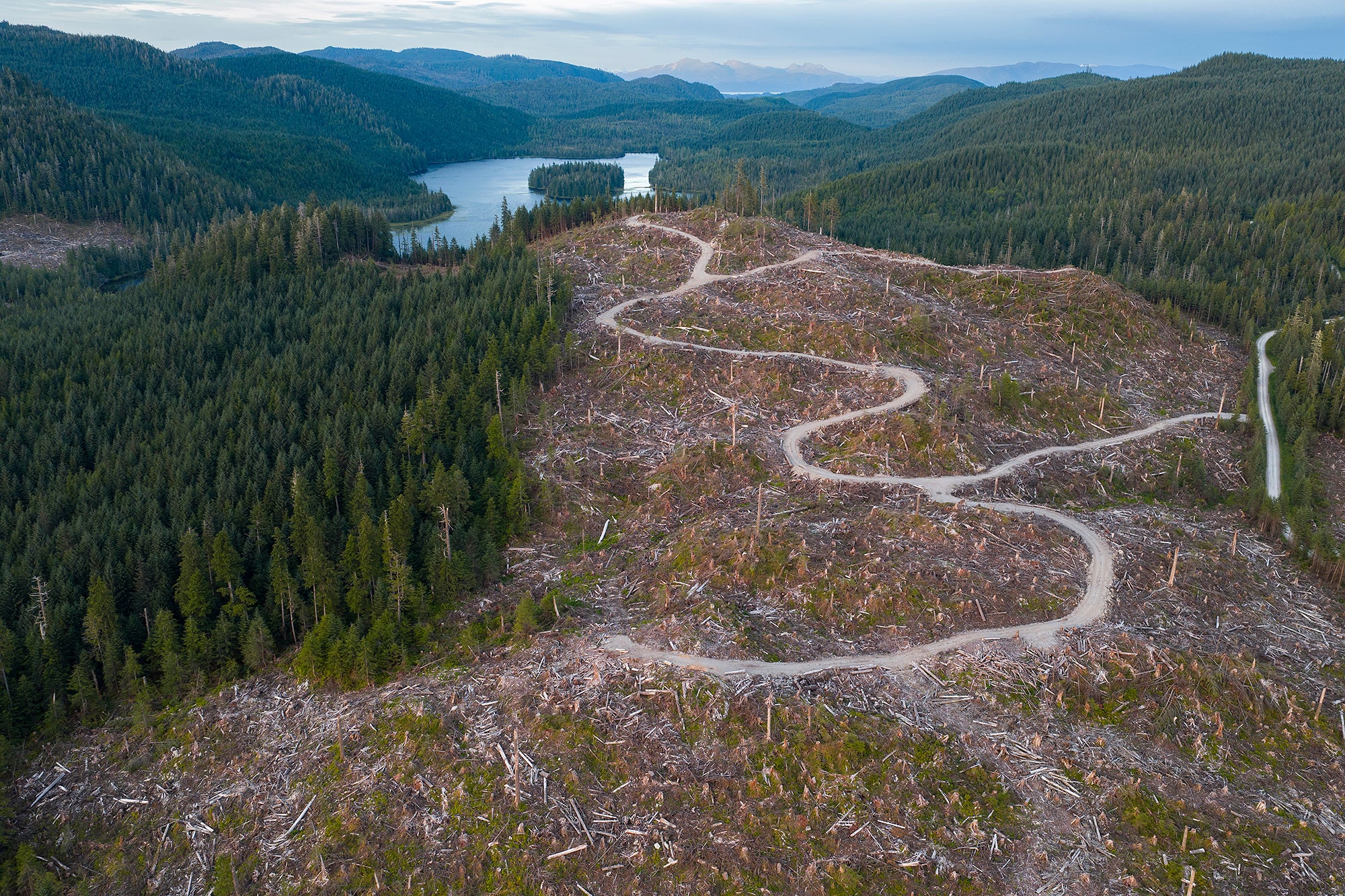
View of a clearcut on land owned by a State of Alaska corporation, adjacent to the Tongass National Forest on Prince of Wales Island. (David Herasimtschuk for Earthjustice)
Nearly 78% of the contiguous old growth on north Prince of Wales Island, which includes Kasaan, has been logged, according to a 2019 analysis; 60% of the region’s remaining old growth will be at risk if the Roadless Rule is repealed.
Stormy is now working with the Forest Service to document what’s left of the remaining old-growth trees on Prince of Wales. His goal is to help people realize how few big trees are left so they will be motivated to help save them.
The trees in the Tongass take many hundreds of years to mature, he said, but because the whole forest ecosystem has been disrupted, it will be the next generation of trees, growing slowly beneath a restored forest canopy, that will produce strong enough wood to harvest for canoes, totem poles, or long houses that are important to his Haida culture.
Stormy said he sees the Roadless Rule as a big idea that helped bring people together around a mindset that places importance on conserving the forest for future generations. People were starting to work together well — tribes, conservationists, the Forest Service, even small local sawmills — toward a healthy and sustainable future.
He said the current push to return large-scale logging to public lands like the Tongass seems ignorant, or even arrogant. “People don’t understand how we live our life here and don’t appear to care,” he said. “They seem to think their way of life is best and more important.”

Old-growth trees on Kuiu Island, Tongass National Forest, Alaska. (David Herasimtschuk for Earthjustice)
It’s hard to say if it would even work, economically. When two regional pulp mills closed in the 1990s, most of the easy-to-reach old growth had already been cut, Stormy said, and without subsidies, the mills couldn’t continue. The pulp market has since moved to other parts of the country where trees can be grown quickly and harvested more cheaply. And recycling has decreased at least some of the demand.
But what he does fear — if this administration succeeds at rolling back forest protections — is an industry focused again on harvesting large volumes of high-value old growth that is the easiest to reach, even if it means logging by helicopter. Few people on Prince of Wales or in Southeast Alaska want this kind of logging to return, he said.
“We’re just going to keep fighting until the forest is protected and not let up,” said Della Coburn, Vice President of the Organized Village of Kasaan.
A forest community
Down the road from Stormy’s house, George Nix, the tribe’s food security manager and treasurer of the Organized Village of Kasaan’s tribal council, is skinning a deer.
Nix is Haida but grew up in Washington state. He and his family moved to Kasaan three years ago to live closer to his culture. “It was like returning home to what I never knew was home,” he said. “When you have a common unity between people, that’s what creates community.”
Nix said he feels a responsibility to ensure the forest is protected now and well into the future. “As a Haida man, I really rely on the forest.” Nix’s job is to hunt and harvest traditional foods and provide them to the community.
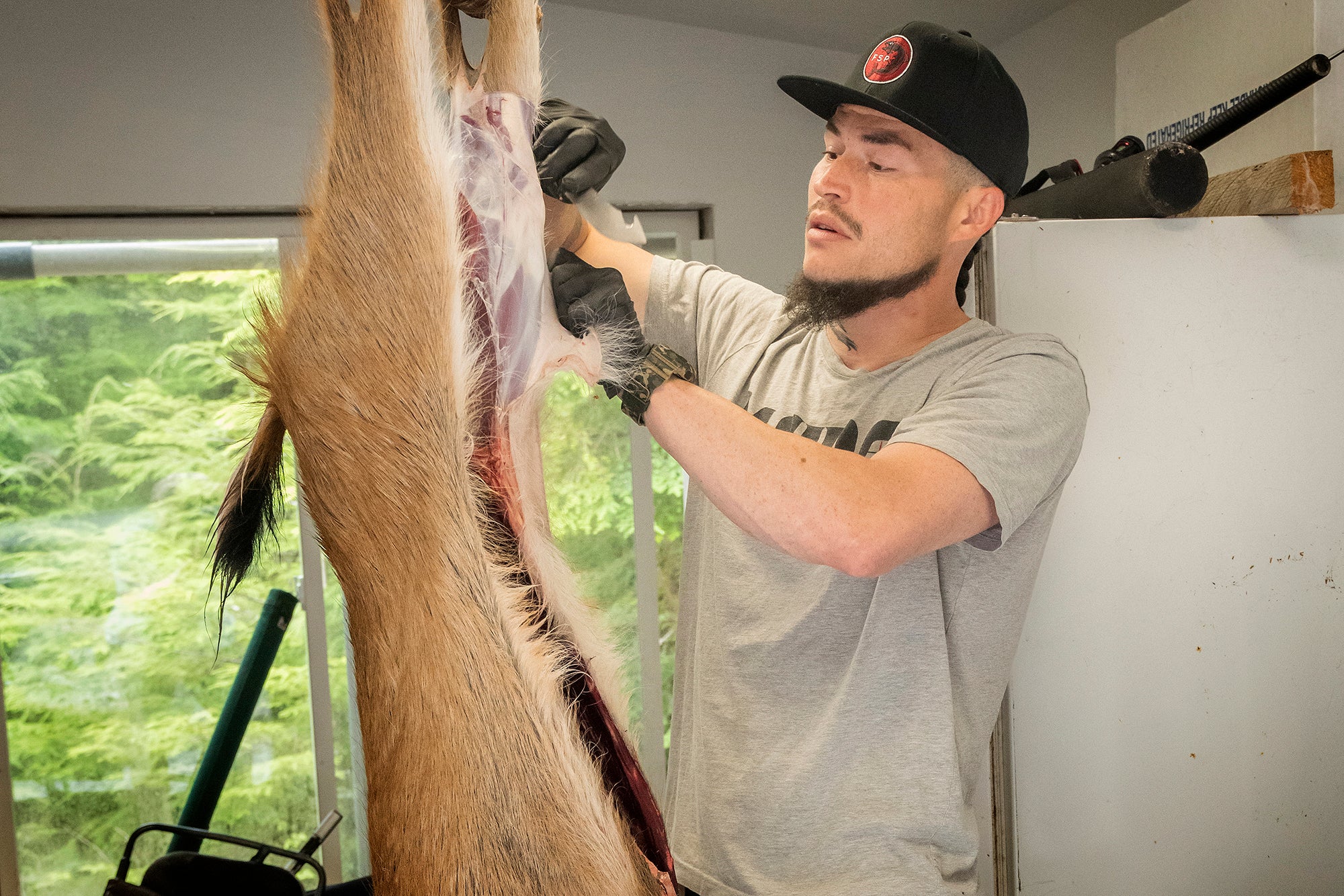
George Nix, Food Security Manager for the Organized Village of Kasaan, skins a buck. (David Herasimtschuk for Earthjustice)
In recent years, Nix said deer have diminished on Prince of Wales because of the loss of old-growth forests. Nearby sockeye salmon runs, too, have been unpredictable in recent years, which could be partly due to logging. He and others are also seeing more landslides in previously logged areas, which can threaten communities and clog salmon streams.
Even with all these changes, Nix said he’s grateful that the forest still provides what his people need. After he finished skinning the buck, Nix vacuum-packed some deer meat and delivered it to two elders, who accepted the gift with hugs and an exchange of family news. Delivering food to the community, especially to elders, is the favorite part of his day. “I want to make sure they get the foods they were eating long before I was here,” Nix said.
A familiar fight
Eric Hamar is an artist and a carver like his father, Stormy, and on top of other jobs he holds in the community, he’s the watchman for the tribe’s carving shed, which is where we found him. Eric talked as he worked. He said he feels exasperated when he hears politicians or others talk about reviving the logging industry in Southeast Alaska.
“Logging won’t save our community,” Hamar said. “It’s a dead thing, a done thing, and some people can’t get over that. They can’t accept that it’s done. It’s not about the trees. The oil, the trees, the minerals — it’s all bargaining chips for power.”
“It’s not anything new,” he continued. “It’s just very blatant and in your face. These are fights we’ve been having for a long time; non-stop we’ve been having these fights, longer than I’ve been alive.”
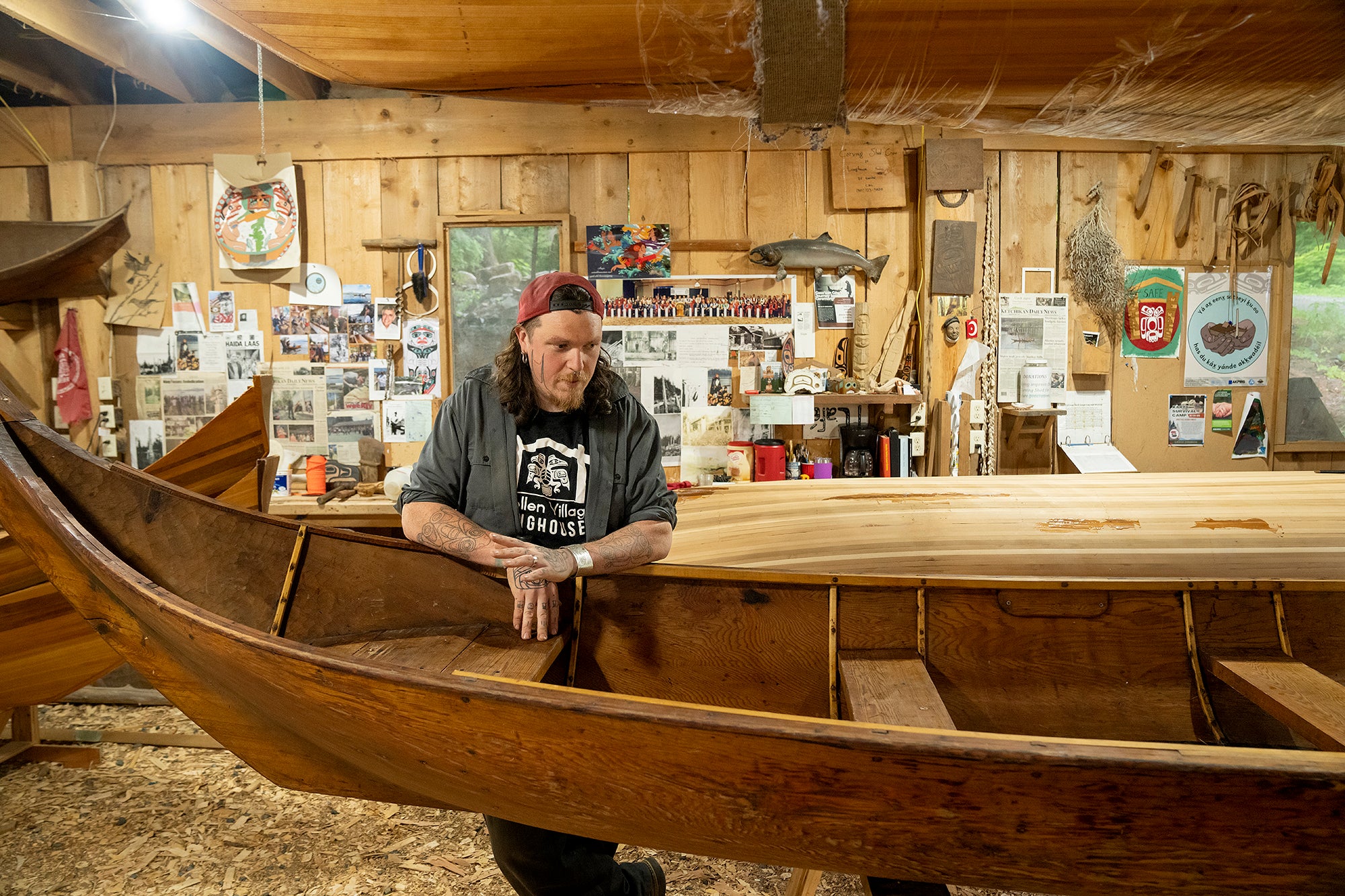
Eric Hamar is a Haida artist and carver. He is also the Carving Shed Watchman and Juvenile Success Officer/Community Wellness Coordinator for the Organized Village of Kasaan. (David Herasimtschuk for Earthjustice)
Even though it gets old, Eric said he knows they must continue to defend the forest and their community. Perseverance is part of life here, he reflected, recalling a recent long-distance journey in a traditional Haida canoe carved by him and his father.
The sea grew rough, with waves so big the canoe was riding up and down into the troughs. His seven-year-old daughter, Eulach (pronounced Oolie), sat in the front, holding her paddle suspended in the air on one stroke when the canoe was high on a wave, and then digging it into the water on the next stroke.
It was difficult and a little scary, he said, but because his culture is built on mutual respect and everyone has spent lifetimes navigating adversity, Eric said they all instinctively knew what to do and kept paddling without speaking. Onward, through the waves.
Opened in 1978, our Alaska regional office works to safeguard public lands, waters, and wildlife from destructive oil and gas drilling, mining, and logging, and to protect the region's marine and coastal ecosystems.